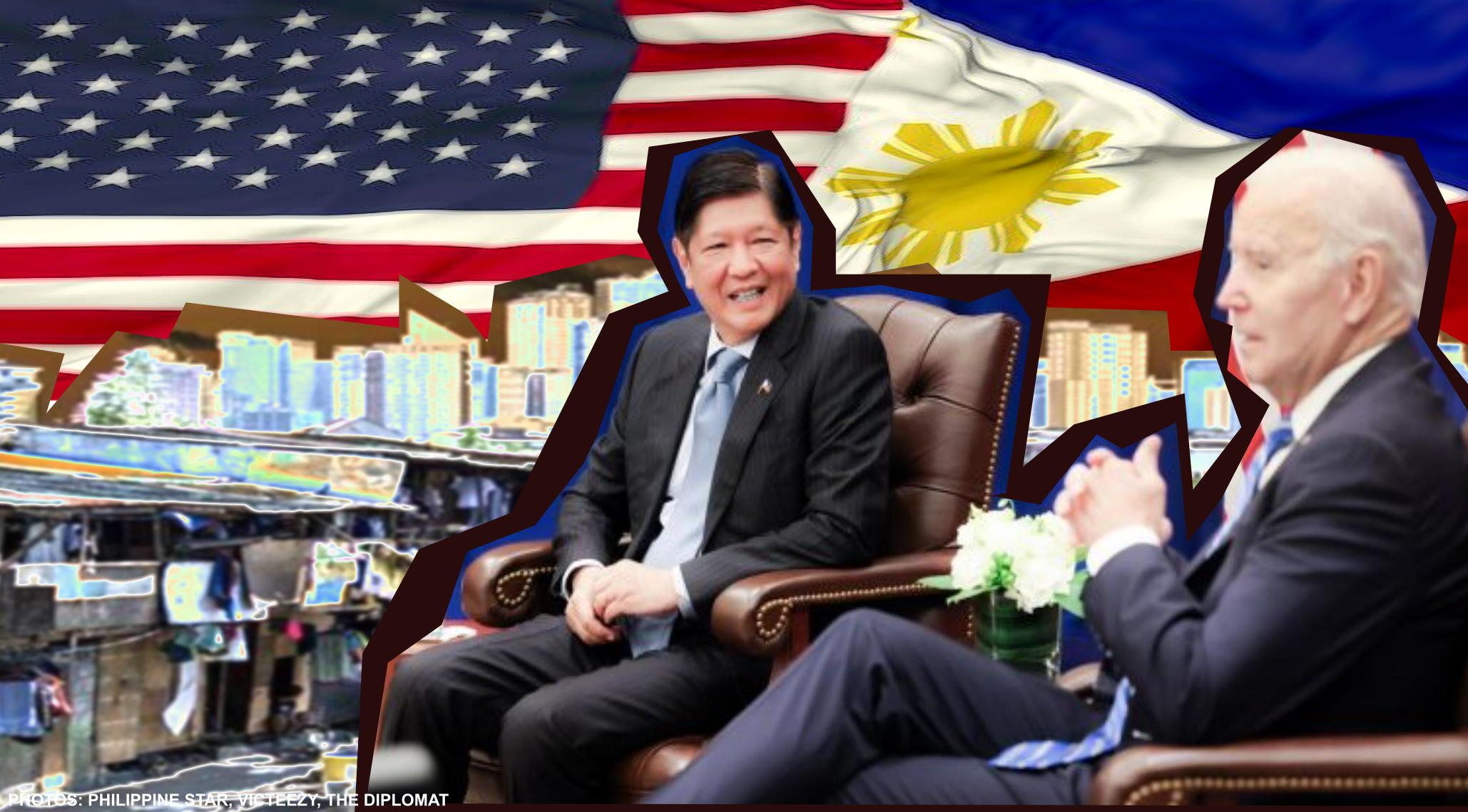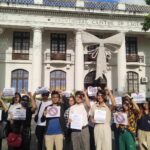The Marcos Jr administration went all out to commemorate the 126th anniversary of Philippine Independence with a 3-day festival of activities and events. However, all the celebratory hullabaloo and hype of “hard-won independence” and being a “free country” distorts how Philippine independence is nominal without true self-determination. For decades, the country has been forced to prioritize United States (US) economic interests, in a trend that continues to this day under the current government and which remains largely obscured.
Shaped to serve US economic interests
June 12 marks the day that the Philippines declared independence from Spain but then only “under the protection of the Mighty and Humane North American Nation.” Even our flag today which is used to stir nationalism bears the mark of US colonialism, with the declaration also saying that the “colors blue, red, and white commemorate those of the flag of the United States of North America, in profound gratitude towards that great Nation for the disinterested protection she is extending to us and will continue to extend to us.”
What should have been a genuine hard-won independence for the Filipino people against their oppressive Spanish colonizers ended up being stolen from them. In the wake of a staged battle in Manila Bay to end the Spanish-American War, Spain sold the Philippines to the US for US$20 million with the signing of the Treaty of Paris in 1898.
The bloody Philippine-American War ensued soon after as the Filipino revolutionaries fought being subjugated by a new colonizer. The US eventually suppressed the rebellion through a brutal campaign that killed hundreds of thousands of Filipinos. So began over half a century (1898-1946) of direct US colonial rule of the Philippines.
Even after granting the Philippines independence in 1946, the US government ensured that the Philippines would continue to serve its economic interests through various one-sided laws and treaties with the help of its post-colonial puppet administrations.
For instance, the 1946 US-RP Treaty of General Relations and the Parity Amendment to the Philippine Constitution in 1947 gave American corporations and citizens the same rights as Filipinos so that they could freely engage in various industries and plunder natural resource. The US also ensured continued free trade with the Philippines through the Bell Trade Act of 1946 and Laurel-Langley Agreement of 1955, which secured American firms’ ready access to the country’s resources and markets. The Laurel-Langley Agreement also had a provision extending parity rights to Philippine natural resources and public utilities up until its 1974 expiration.
Neocolony
The US initiated and pushed neoliberal economic policies under the Marcos Sr dictatorship. These included policies on cheap labor export, export processing zones, wage repression and opening up the agriculture sector to American firms’ chemical inputs. Using its control of international financial institutions, the US used World Bank structural adjustment programs and International Monetary (IMF) stabilization programs to dictate policymaking that favored foreign monopoly interests, way ahead of the neoliberal globalization promoted globally in the 1980s and 1990s.
In the decades that followed, trade and investment liberalization, privatization, and deregulation were implemented and advanced throughout the Philippine economy. Trade barriers were taken down. Laws were enacted to circumvent foreign ownership restrictions in the 1987 Constitution and permit 100% foreign ownership in many sectors. Such sectors include mining, telecommunications, transport, power generation, manufacturing, construction, retail trade, banking and finance, among others.
The US has shaped the Philippine economy to primarily function as a low value-added segment of global value chains that benefit and are controlled by the US and other big capitalists. As a colony then and a neocolony now, the Philippines is used for its cheap labor and resources, as well as serving as a market and destination for surplus capital to make more profits.
Pulling Marcos Jr’s strings
The Marcos Jr administration adheres to the same neoliberal framework that its predecessors followed, allowing for increased profits for the US and other foreign powers at the expense of Philippine national development. This underscores the lack of genuine independence in the Philippines.
The current Marcos government continues to further open up the economy and create more profitable opportunities for foreign capitalists. This is by upholding existing policies like the amended Public Services and Foreign Investment Acts, which both allow 100% foreign ownership in many sectors. It also pursues further trade liberalization, for instance reducing tariffs on rice imports, which benefit foreign producers.
More recently, the US has been securing its economic interests through the Indo-Pacific Economic Framework for Prosperity (IPEF), a 4-pillar trade deal with 14 countries in Asia Pacific, including the Philippines. In line with the US industrial strategy, the IPEF overall seeks to strengthen US supply chains in the region and ensure the profitability of its investments.
The Philippines is being established as a key IPEF hub as evidenced by the US Trade Mission and the Indo-Pacific Business Forum held in the Philippines in the first half of this year. Meanwhile, also in line with IPEF, the Luzon Economic Corridor will be developed and helmed by the US in coordination with Japan and the Philippines to drive and facilitate investments in high-impact infrastructure projects and critical supply chains, particularly in semiconductors, clean energy and agribusiness.
With the US intent on securing and advancing its energy and semiconductor sectors as part of its nationalist industrial strategy, the Philippines can provide cheap labor and raw materials, particularly critical minerals like nickel. Nickel is an important element for all clean energy technologies and the Philippines is the world’s second largest producer of this mineral with the sixth largest reserves.
FDI for Filipinos?
The Marcos administration is eagerly on board with the IPEF in the hopes of attracting more foreign capital to the country. It claims that more foreign investments, trade, and loans will be beneficial to the Philippine economy and further development. But a closer look at these reveals it’s really the US and other foreign powers that are reaping the gains at the expense of national development.
Net foreign direct investment (FDI) flows in the Philippines totaled US$8.9 billion in 2023. For the FDI where country breakdown statistics are available, the US accounted for the third biggest share of FDI at US$113 million, after Japan (US$849 million) and Singapore (US$183 million). As it is, the US accounts for the second largest cumulative FDI in the country at US$18.4 billion next only to Japan’s US$29.1 billion, according to the United Nations Conference on Trade and Development (UNCTAD).
The biggest part of these foreign investments is in the manufacturing sector which is now dominated by foreign capital. According to Philippine Statistics Authority (PSA) data, the average share of foreign investments in manufacturing was 52% annually from 2011 to 2022. Of course, as a result, foreign firms mainly profited: among the top 1,000 corporations in the Philippines, foreign transnational corporations (TNCs) accounted for Php3.2 trillion or 56.3% of total gross revenues in manufacturing (Php5.8 trillion) in 2022. Of these TNC revenues, the US accounted for 23.3% or Php754 billion.
Foreign investments which have generated huge profits for TNCs have not translated into building the capacity of Filipino industries. For instance, when American firm Intel ended its operations in the Philippines in 2009, despite US$1.5 billion in investments over 35 years, the country still had no semiconductor capacity. Despite allowing 100% foreign ownership, manufacturing share in the gross domestic product (GDP) is the smallest in 75 years.
Trade has been more beneficial to foreign exporters and left the Philippines with a chronic and worsening trade deficit. From US$232 million in 1946, the country’s trade deficit has grown to US$52.6 billion in 2023. Agricultural trade also went from a surplus of US$1.4 billion in 1980 to a deficit of US$11.5 billion in 2023.
While it appears that the Philippines has a trade surplus with the US, this does not mean the domestic economy and Filipino producers have benefited. In 2023, over 60% of exports from the Philippines to the US consisted of electronics, ignition wiring sets, machinery and transport equipment – not Filipino products. These were mainly produced by the foreign firms located in the country that have no contribution towards building domestic industrial capacity.
Breaking neocolonial chains
The US and its local client states have for decades projected the illusion that the Philippines is independent and that they are upholding and defending that independence. But decades of US economic intervention and its entrenchment in the Philippine economy to advance its interests to the detriment of national development reveals how the country’s independence is illusory.
The Marcos Jr administration perpetuates this one-sided situation by aligning with the US and condoning its self-serving interventions whether military or economic. Genuine independence can never be realized and national development will remain stunted in this way. The recently concluded Independence Day commemorations were in affect only theatrics to cover how the Philippines remains an instrument of the US to secure and advance its interests in the region.
The persistent alignment of economic policy with US preferences drastically limits the Philippines’ policy space and severely constrains the country‘s ability to pursue the national agricultural and industrial development policies so necessary to achieve genuine sovereignty and independence.



